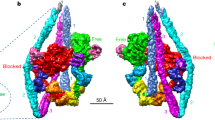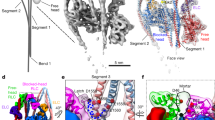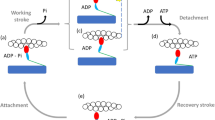Abstract
Many of the functional domains of the myosin molecule have been defined by the use of proteolytic enzymes. Major fragments that retain enzymatic or assembly properties have been prepared by cleavage in the rod to form heavy meromyosin (HMM) and light meromyosin (LMM)1 or at the head–rod junction to form S-1 and rod2,3. Limited tryptic digestion of vertebrate skeletal myosin S-14 indicates that the head contains three major regions: an ammo-terminal nucleotide binding domain of molecular weight (MW) 25,0005,6, a central domain of MW 50,000 and a carboxyl domain MW 20,000; the latter two are both able to bind to actin7,8. Tryptic digestion of scallop S-1 has also been used to isolate a head fragment MW 14,000 associated with both types of scallop light chains9. Here we report that myosin from vertebrate (chicken and rabbit skeletal) and molluscan (scallop adductor) striated muscles is cleaved in an unusual way with an enzyme from Pseudomonas aeruginosa10–12. This bacterial protease (designated Ps-1) does not cleave myosin at the head–rod junction or in the rod; instead, Ps-1 splits the myosin heavy chain within the head, yielding a complete rod joined to the 20,000-MW head domains. The scallop regulatory and essential light chains remain associated with this fragment. We examined this new fragment by electron microscopy; the rods bear two ‘nubs’ about 100 Å long, which appear to correspond morphologically to the neck region of the myosin molecule13,14.
This is a preview of subscription content, access via your institution
Access options
Subscribe to this journal
Receive 51 print issues and online access
$199.00 per year
only $3.90 per issue
Buy this article
- Purchase on Springer Link
- Instant access to full article PDF
Prices may be subject to local taxes which are calculated during checkout
Similar content being viewed by others
References
Lowey, S. & Cohen, C. J. molec. Biol. 4, 293–308 (1962).
Lowey, S., Slayter, H. S., Weeds, A. G. & Baker, H. J. molec. Biol. 42, 1–29 (1969).
Weeds, A. G. & Pope, B. J. molec. Biol. 111, 129–157 (1977).
Balint, M., Wolf, I., Tarcsafalvi, A., Gergely, J. & Sreter, F. Archs Biochem. Biophys. 190, 793–799 (1978).
Szilagyi, L., Balint, M., Sreter, F. A. & Gergely, J. Biochem. biophys. Res. Commun. 87, 936–945 (1979).
Walker, J. E., Saraste, M., Runswick, M. J. & Gay, N. J. EMBO J. 1, 945–951 (1982).
Mornet, D., Bertrand, R., Pantel, P., Audemard, E. & Kassab, R. Nature 292, 301–306 (1981).
Sutoh, K. Biochemistry 21, 4800–4804 (1982).
Szentkiralyi, E. M. Biophys. J. 37, 39a (1982). J. Muscle Res. Cell Motility (in the press).
Tooney, N. M. & Cohen, C. Nature 237, 23–25 (1972).
Cohen, C. & Tooney, N. M. Nature 251, 659–660 (1974).
Tooney, N. M. & Cohen, C. J. molec. Biol. 110, 363–385 (1977).
Vibert, P. & Craig, R. J. molec. Biol. 157, 299–319 (1982).
Flicker, P. F., Wallimann, T. & Vibert, P. J. molec. Biol. 169, 723–741 (1983).
Reisler, E., Burke, M. & Harrington, W. F. Biochemistry 13, 2014–2022 (1974).
Hozumi, T. Biochemistry 22, 799–804 (1983).
Szent-Györgyi, A. G., Szentkiralyi, E. M. & Kendrick-Jones, J. J. molec. Biol. 74, 179–203 (1973).
Sherry, J. M. F., Gorecka, A., Askoy, M. O., Dabrowska, R. & Hartshorne, D. J. Biochemistry 17, 4411–4418 (1978).
Elliott, A. & Offer, G. J. molec. Biol. 123, 505–519 (1978).
Winkelmann, D. A., Lowey, S. & Press, J. Cell 34, 295–306 (1983).
Stafford, W. F. III, Szentkiralyi, E. M. & Szent-Györgyi, A. G. Biochemistry 18, 5273–5280 (1979).
Hardwicke, P. M. D., Wallimann, T. & Szent-Györgyi, A. G. Nature 301, 478–482 (1983).
Sellers, J. R., Pato, M. D. & Adelstein, R. S. J. biol. Chem. 256, 13137–13142 (1981).
Kendrick-Jones, J., Jakes, R., Tooth, P., Craig, R. & Scholey, J. in Basic Biology of Muscles: A Comparative Approach (eds Twarog, B. M., Levine, R. J. C. & Dewey, M. M.) 255–272 (Raven, New York, 1982).
Wagner, P. D. & Stone, D. B. Biochemistry 22, 1334–1342 (1983).
Amos, L. A., Huxley, H. E., Holmes, K. C., Goody, R. S. & Taylor, K. A. Nature 299, 467–469 (1982).
Laemmli, U. K. Nature 227, 680–685 (1970).
Wallimann, T. & Szent-Györgyi, A. G. Biochemistry 20, 1176–1187 (1981).
Author information
Authors and Affiliations
Rights and permissions
About this article
Cite this article
Winkelmann, D., Almeda, S., Vibert, P. et al. A new myosin fragment: visualization of the regulatory domain. Nature 307, 758–760 (1984). https://doi.org/10.1038/307758a0
Received:
Accepted:
Issue Date:
DOI: https://doi.org/10.1038/307758a0
This article is cited by
-
NMIIA promotes tumor growth and metastasis by activating the Wnt/β-catenin signaling pathway and EMT in pancreatic cancer
Oncogene (2019)
-
Role of gizzard myosin light chains in calcium binding
Journal of Muscle Research and Cell Motility (1992)
-
Structural changes induced in scallop heavy meromyosin molecules by Ca2+ and ATP
Journal of Muscle Research and Cell Motility (1992)
-
Efficiency of muscle contraction. The chemimechanic equilibrium
Naturwissenschaften (1991)
-
Amino acid sequences of myosin essential and regulatory light chains from two clam species: Comparison with other molluscan myosin light chains
Journal of Muscle Research and Cell Motility (1991)
Comments
By submitting a comment you agree to abide by our Terms and Community Guidelines. If you find something abusive or that does not comply with our terms or guidelines please flag it as inappropriate.



